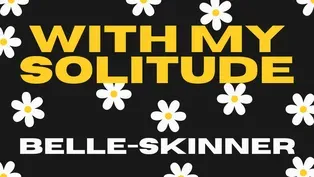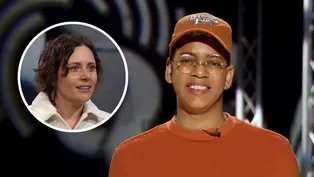
Ryan Parr: From Kitchen Towels to Artistic Inspiration
Clip: Season 8 Episode 24 | 6m 24sVideo has Closed Captions
Discover artist Ryan Parr's unconventional approach to art.
When artist Ryan Parr felt that painting had lost its meaning, he turned to his sketchbook and started drawing the kitchen towel over and over again. Join as we explore Parr's unconventional approach to art and how it has reawakened his creativity.
Problems with Closed Captions? Closed Captioning Feedback
Problems with Closed Captions? Closed Captioning Feedback
AHA! A House for Arts is a local public television program presented by WMHT
Support provided by the New York State Council on the Arts (NYSCA), M&T Bank, the Leo Cox Beach Philanthropic Foundation, and is also provided by contributors to the WMHT Venture...

Ryan Parr: From Kitchen Towels to Artistic Inspiration
Clip: Season 8 Episode 24 | 6m 24sVideo has Closed Captions
When artist Ryan Parr felt that painting had lost its meaning, he turned to his sketchbook and started drawing the kitchen towel over and over again. Join as we explore Parr's unconventional approach to art and how it has reawakened his creativity.
Problems with Closed Captions? Closed Captioning Feedback
How to Watch AHA! A House for Arts
AHA! A House for Arts is available to stream on pbs.org and the free PBS App, available on iPhone, Apple TV, Android TV, Android smartphones, Amazon Fire TV, Amazon Fire Tablet, Roku, Samsung Smart TV, and Vizio.
Providing Support for PBS.org
Learn Moreabout PBS online sponsorship- I'm here in Albany New York to meet with painter Ryan Parr.
Follow me.
(cheerful music) - As a child, I always drew, and my neighbor was an artist.
We'd stay up all night and draw, Conan the Barbarian and Indiana Jones.
That's really where it started.
You had two options as a kid, you go outside and play or you draw a picture.
For the last, oh, I would say, 20 years, I've been painting still lifes making something first, and then transforming it into a two-dimensional picture.
(quirky music) In the early 2000s, I had this idea that I wanted to paint a picture of a puzzle and then make that a puzzle, and I painted this giant thing of a puzzle, and it was zoomed in to this swirl of puzzle pieces, and I started to look at it and I just thought, "Oh, this is really- Like, I love the going edge to edge aspect of it, and so that set me off on this almost micro, macro, whatever you wanna call it, view of things.
(gentle rhythmic music) At the same time, I was trying to figure out how you finish a painting.
I wanted there to be a finish line.
And so all those, I gridded out the canvas, and I would work from square to square, but I would cover up 99% of the canvas, and I'd just cut a hole in a giant piece of paper, and I would only paint that square.
And I just went down the line, and when I got to the last one, I would remove it, and the painting was finished, and I wouldn't allow myself to go back and work on them.
And so that evolved and I, you know, I made the square a little bit bigger so I could see how it connected to the other squares, and so the grids slowly disappeared, and over time, they got really detailed.
The last one, I remember, I got to the end, and it was almost photographic, and I was disappointed.
Like, I'd made it to the end, do you know what I mean?
Like I, like, I, yeah, for me, I fulfilled the, I fulfilled the mission, sort of, and I thought, "All right, I have to do something else."
I recently read a book, and the author was talking about, well, how do you find something that you love to do, or, you know, what is it that you're good at?
And it's when it's boring and you're still interested, that's the thing you should stick with.
And that's painting.
It's not always exciting, you know, every one of those squares got really old, but you just keep going back, you know, and there's something in the boredom that is peaceful.
So when Covid happened, I still had paintings I wanted to work on, and I was still working on those paintings.
As Covid drug on, I started to, like, question all of it, you know, like, why do any of this, you know?
And I sat on the deck and stared at the bushes for a long time, or on the couch or where, you know, and I drew, I just drew my in sketchbook.
Making big paintings seemed pointless, I guess.
And at some point, I started to draw kitchen towels.
Every morning, I'd try to put something out into the world before I consume it, which, consuming is just looking at your stupid phone, you know, so, and I do that to this day.
And what I was putting out was I would draw the kitchen towel, 'cause I was drinking my coffee, it's 5:00 in the morning, you know, quietly in the kitchen, and I would draw the kitchen towel, and I got really into fabric, and then the pattern on the fabric, and soon, those drawings became big drawings, and it just kind of snowballed from there, and those fabrics became flags.
For a lot of years, it was photography.
I used photography as the starting point, you know, setting up the diorama and then photographing it, and so then I would paint from these photographs.
The thing I liked about the fabric, and what I started to get excited about again, was drawing and painting from life, and so that's where it's been for the last year.
The newest series, I've just taken scenes from my home that already existed, still lifes that were set up, but not intentionally as still lifes.
I've always liked that idea of, you know, like a photographer would, go around and you photograph what exists, right?
And so I was thinking about things in my home that already existed that could function as a still life, sculptures that my daughter did, a sculpture that an old friend did, a photograph of me proposing to my wife, things that exist in your family home, or in my case, my studio.
I've always just wanted to get better, you know, like, and that's hard to quantify in the arts.
How do you get better at something?
I think, as an artist, you figure out your own way to quantify it, but for me, it's been some of just the basics, like, can I render a piece of fabric, you know, and can I get better at rendering that piece of fabric?
When you're 18 years old, you get to see the improvements quickly, you know.
When you're 47 years old, they're slower, you know, but it is happening.
And I, you know, I draw every day, and so, you know, the achievements are smaller and less noticeable, but yes, I am getting better, I can proudly say, yes (chuckles).
(serene music)
Video has Closed Captions
Preview: S8 Ep24 | 30s | Unconventional art, film industry breakthrough, and enchanting music. (30s)
Belle-Skinner Performs 'Magic' Live
Video has Closed Captions
Clip: S8 Ep24 | 3m 35s | Don't miss Belle-Skinner's performance of "Magic" from her latest EP Love Spell. (3m 35s)
Belle-Skinner Performs 'With My Solitude' Live
Video has Closed Captions
Clip: S8 Ep24 | 3m 31s | Don't miss Belle-Skinner's performance of "With My Solitude". (3m 31s)
Breaking into the Film Industry: Noëlle Gentile's Journey
Video has Closed Captions
Clip: S8 Ep24 | 10m 2s | Learn how Noëlle broke into the film industry and her rise to success. (10m 2s)
Providing Support for PBS.org
Learn Moreabout PBS online sponsorshipSupport for PBS provided by:
AHA! A House for Arts is a local public television program presented by WMHT
Support provided by the New York State Council on the Arts (NYSCA), M&T Bank, the Leo Cox Beach Philanthropic Foundation, and is also provided by contributors to the WMHT Venture...















